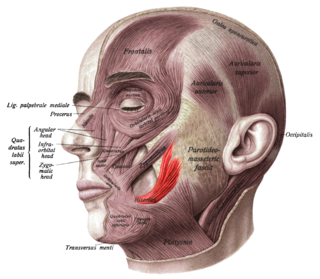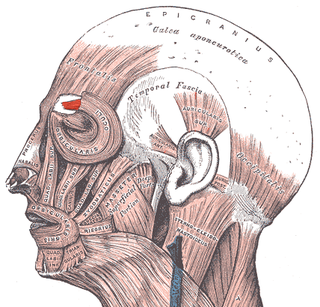
Ramsay Hunt syndrome type 2, commonly referred to simply as Ramsay Hunt syndrome (RHS) and also known as herpes zoster oticus, is inflammation of the geniculate ganglion of the facial nerve as a late consequence of varicella zoster virus (VZV). In regard to the frequency, less than 1% of varicella zoster infections involve the facial nerve and result in RHS. It is traditionally defined as a triad of ipsilateral facial paralysis, otalgia, and vesicles close to the ear and auditory canal. Due to its proximity to the vestibulocochlear nerve, the virus can spread and cause hearing loss, tinnitus, and vertigo. It is common for diagnoses to be overlooked or delayed, which can raise the likelihood of long-term consequences. It is more complicated than Bell's palsy. Therapy aims to shorten its overall length, while also providing pain relief and averting any consequences.

The face is the front of an animal's head that features the eyes, nose and mouth, and through which animals express many of their emotions. The face is crucial for human identity, and damage such as scarring or developmental deformities may affect the psyche adversely.

Möbius syndrome or Moebius syndrome is a rare congenital neurological disorder which is characterized by facial paralysis and the inability to move the eyes from side to side. Most people with Möbius syndrome are born with complete facial paralysis and cannot close their eyes or form facial expressions. Limb and chest wall abnormalities sometimes occur with the syndrome. People with Möbius syndrome have normal intelligence, although their lack of facial expression is sometimes incorrectly taken to be due to dullness or unfriendliness. It is named for Paul Julius Möbius, a German neurologist who first described the syndrome in 1888. In 1994, the "Moebius Syndrome Foundation" was founded, and later that year the first "Moebius Syndrome Foundation Conference" was held in Los Angeles.
Facial expression is the motion and positioning of the muscles beneath the skin of the face. These movements convey the emotional state of an individual to observers and are a form of nonverbal communication. They are a primary means of conveying social information between humans, but they also occur in most other mammals and some other animal species.

Body language is a type of nonverbal communication in which physical behaviors, as opposed to words, are used to express or convey information. Such behavior includes facial expressions, body posture, gestures, eye movement, touch and the use of space. Although body language is an important part of communication, most of it happens without conscious awareness. In social communication, body language often complements verbal communication.

Guillaume-Benjamin-Amand Duchenne was a French neurologist who revived Luigi Galvani's research and greatly advanced the science of electrophysiology. The era of modern neurology developed from Duchenne's understanding of neural pathways and his diagnostic innovations including deep tissue biopsy, nerve conduction tests (NCS), and clinical photography. This extraordinary range of activities was achieved against the background of a troubled personal life and a generally indifferent medical and scientific establishment.
Amusement is the state of experiencing humorous and entertaining events or situations while the person or animal actively maintains the experience, and is associated with enjoyment, happiness, laughter and pleasure. It is an emotion with positive valence and high physiological arousal.

The Facial Action Coding System (FACS) is a system to taxonomize human facial movements by their appearance on the face, based on a system originally developed by a Swedish anatomist named Carl-Herman Hjortsjö. It was later adopted by Paul Ekman and Wallace V. Friesen, and published in 1978. Ekman, Friesen, and Joseph C. Hager published a significant update to FACS in 2002. Movements of individual facial muscles are encoded by the FACS from slight different instant changes in facial appearance. It has proven useful to psychologists and to animators.

A dimple, also called a gelasin, and a fovea buccalis, is a small natural indentation in the flesh on a part of the human body, most notably in the cheek. Numerous cultures believe that cheek dimples are a good luck charm that entices people who perceive them as physically attractive, but they are also associated with heroism and innocence, which has been included in literature for many centuries.
An emotional expression is a behavior that communicates an emotional state or attitude. It can be verbal or nonverbal, and can occur with or without self-awareness. Emotional expressions include facial movements like smiling or scowling, simple behaviors like crying, laughing, or saying "thank you," and more complex behaviors like writing a letter or giving a gift. Individuals have some conscious control of their emotional expressions; however, they need not have conscious awareness of their emotional or affective state in order to express emotion.

The zygomaticus major muscle is a muscle of the face. It arises from either zygomatic arch (cheekbone); it inserts at the corner of the mouth. It is innervated by branches of the facial nerve.

The risorius muscle is a highly variable muscle of facial expression. It has numerous and very variable origins, and inserts into the angle of the mouth. It receives motor innervation from branches of facial nerve. It may be absent or asymmetrical in some people. It pulls the angle of the mouth sidewise, such as during smiling.

A frown is a facial expression in which the eyebrows are brought together, and the forehead is wrinkled, usually indicating displeasure, sadness or worry, or less often confusion or concentration. The appearance of a frown varies by culture. An alternative usage in North America is thought of as an expression of the mouth. In those cases when used iconically, as with an emoticon, it is entirely presented by the curve of the lips forming a down-open curve. The mouth expression is also commonly referred to in the colloquial English phrase, especially in the United States, to "turn that frown upside down" which indicates changing from sad to happy.
The facial feedback hypothesis, rooted in the conjectures of Charles Darwin and William James, is that one's facial expression directly affects their emotional experience. Specifically, physiological activation of the facial regions associated with certain emotions holds a direct effect on the elicitation of such emotional states, and the lack of or inhibition of facial activation will result in the suppression of corresponding emotional states.
Discrete emotion theory is the claim that there is a small number of core emotions. For example, Silvan Tomkins concluded that there are nine basic affects which correspond with what we come to know as emotions: interest, enjoyment, surprise, distress, fear, anger, shame, dissmell and disgust. More recently, Carroll Izard at the University of Delaware factor analytically delineated 12 discrete emotions labeled: Interest, Joy, Surprise, Sadness, Anger, Disgust, Contempt, Self-Hostility, Fear, Shame, Shyness, and Guilt.
The study of the evolution of emotions dates back to the 19th century. Evolution and natural selection has been applied to the study of human communication, mainly by Charles Darwin in his 1872 work, The Expression of the Emotions in Man and Animals. Darwin researched the expression of emotions in an effort to support his materialist theory of unguided evolution. He proposed that much like other traits found in animals, emotions apparently also evolved and were adapted over time. His work looked at not only facial expressions in animals and specifically humans, but attempted to point out parallels between behaviors in humans and other animals.

Facial electromyography (fEMG) refers to an electromyography (EMG) technique that measures muscle activity by detecting and amplifying the tiny electrical impulses that are generated by muscle fibers when they contract.
Mécanisme de la physionomie humaine. ou, Analyse électro-physiologique de l'expression des passions des arts plastiques. is a monograph on the muscles of facial expression, researched and written by Guillaume-Benjamin-Amand Duchenne de Boulogne (1806–75). It first appeared as an abstract published in Archives générales de médecine in 1862 and was then published in three formats: two octavo editions and one quarto edition. The work was an important resource used by Charles Darwin (1809–82) for his own study on the genetics of behaviour, titled The Expression of the Emotions in Man and Animals, and in recent years it has been reclaimed as an important landmark in the history of the photographic arts.
Emotion perception refers to the capacities and abilities of recognizing and identifying emotions in others, in addition to biological and physiological processes involved. Emotions are typically viewed as having three components: subjective experience, physical changes, and cognitive appraisal; emotion perception is the ability to make accurate decisions about another's subjective experience by interpreting their physical changes through sensory systems responsible for converting these observed changes into mental representations. The ability to perceive emotion is believed to be both innate and subject to environmental influence and is also a critical component in social interactions. How emotion is experienced and interpreted depends on how it is perceived. Likewise, how emotion is perceived is dependent on past experiences and interpretations. Emotion can be accurately perceived in humans. Emotions can be perceived visually, audibly, through smell and also through bodily sensations and this process is believed to be different from the perception of non-emotional material.
Facial expressions are used to communicate emotions. They can also occur solitarily, without other people being present. People often imagine themselves in social situations when alone, resulting in solitary facial expressions. Toddlers and children in early childhood use social cues and contexts to discriminate and recognize facial expressions. They develop at this early stage facial expressions in order to provoke reactions from their caregivers and receive nurturance and support. Children reflect their peers' emotions in their own expressions for social interaction.











